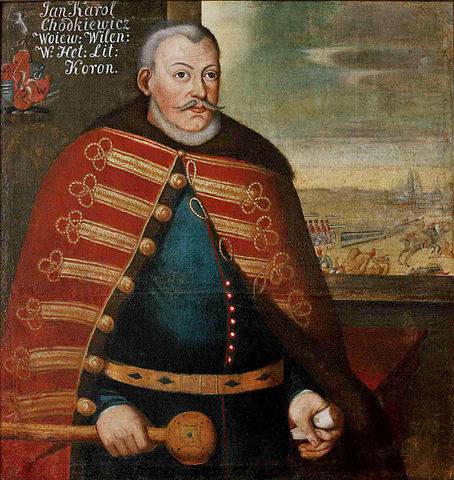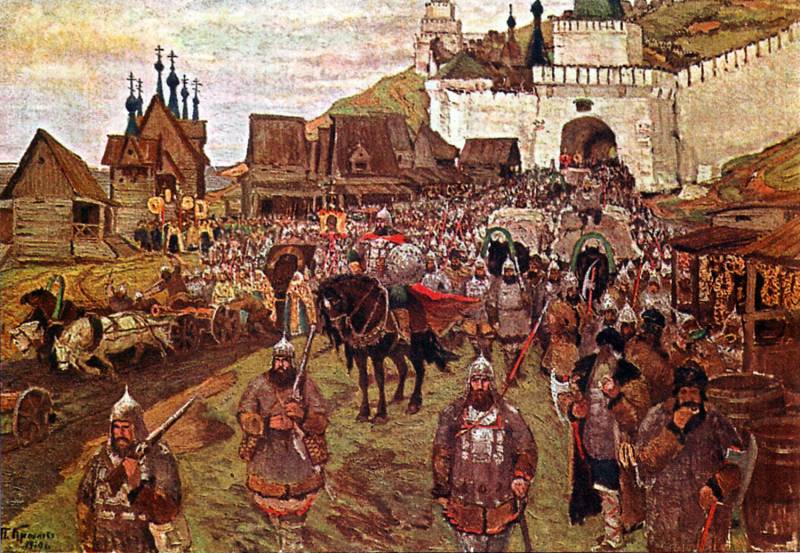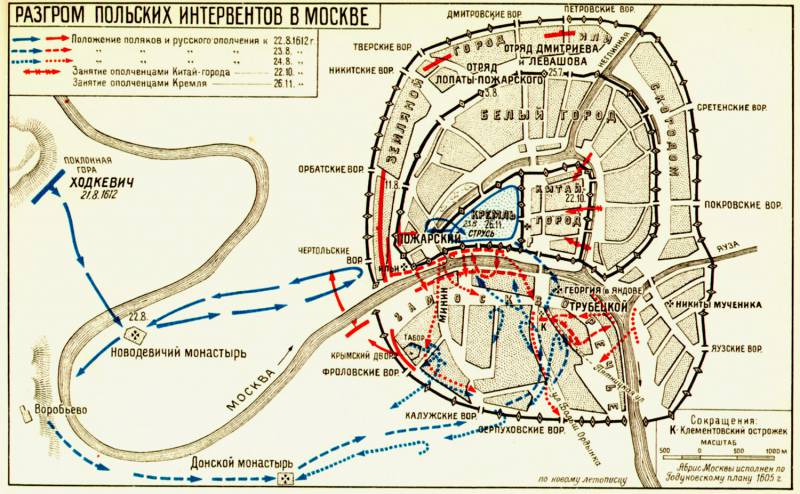"Standing under Moscow ... and beaten to death." Battle of the Russian capital
Preparing for the battle. Forces of the parties
The main forces of Prince Pozharsky with carts and artillery reached the capital 20 August 1612. The chief voivods of the Second Militia were Prince Dmitry Pozharsky, Kuzma Minin, Prince Ivan Andreevich Khovansky-Bolshoi, and Prince Dmitry Pozharsky-Lopata. During the march to the militia, Cossacks from the Moscow “camps” more than once came to investigate whether something was being planned against them. But Dmitry Pozharsky and Kuzma Minin received them invariably friendly, presented with money and cloth and released back to Moscow. Pozharsky and Minin, after Zarutsky left, they wanted to negotiate joint actions with the Moscow camps. We held talks with Trubetskoy, but could not find a common language.
Trubetskoy offered to accommodate all the forces in his already ready camp at the Crimean court (near the Crimean bridge). The Cossacks spent more than a year near Moscow and managed to reinforce their Yauza burg with high ramparts; there were many empty buildings and dugouts in their camp. But there the spirit of the Cossack freemen reigned, threatening to undermine the discipline and order of the Second Militia. In addition, the Zemstvo army, according to local orders, was supposed to obey Trubetskoy - he was, though Tushino, but a boyar, and Pozharsky was only a stolnik. Also, the Cossack camp was from the east of Moscow, and the enemy was expected from the west. Pozharsky decided to open battle with the enemy. Thus, Pozharsky and Minin refused to unite the troops, got up separately, in the west, at the Arbat gate. Thus, Chodkiewicz’s army blocked the main route to the Kremlin.
Had time on time. Since almost simultaneously the Polish troops approached Moscow. King Sigismund II and Prince Vladislav, with Chancellor Sapega, marched to Moscow to seize the throne. But the king could not form a large army, he had only 4 thousand soldiers, and he moved slowly, with stops, summoning the gentry. However, Hetman Jan Chodkiewicz was already on the outskirts of the Russian capital. He collected a large train of supplies and received strong reinforcements - the Lithuanian cavalry, Koretsky, Neverovsky, Mlotsky, Graevsky, Velichinsky detachments, also joined 8 thousand Zaporozhtsy Nalyvayko, Zborovsky and Shiryay. The Lithuanian getman took into account the experience of previous battles and tried to strengthen his army with infantry. The king sent him to reinforce one and a half thousand infantry, many of whom participated in the siege of Smolensk. In general, the Polish army numbered 12-14 thousand soldiers, not counting the servants, plus the Moscow garrison in 3-3,5 thousand people. Strus and Budila were supposed to hit the rear of the Russian army when Hodkevich attacks.
As a result, the main part of the Polish army was the cavalry: Cossacks (Zaporozhian Cossacks and Cherkasy), cavalry Polish cavalry and Hungarian cavalry. Khodkevich had relatively little infantry, and it consisted of mercenaries: Germans, Poles, Hungarians and others. Khodkevich's personal squadron consisted of thousands of 2 warriors. Both hired royal infantry and noble cavalry had good armament: guns, sabers, spears, steel armor. It was a professional army, which skillfully fought a regular system.
It should be noted that the commander in chief of the Polish army Chodkiewicz was an experienced and talented commander. He successfully fought with the Swedes, precisely for the victory over the Swedish army, Chodkiewicz was marked by the title of the Great Hetman of the Grand Duchy of Lithuania. In 1605, in the battle of Kirchholm, Chodkiewicz with several thousand cavalry defeated 11 thousand Swedish army of King Charles IX. Then Jan Chodkiewicz actively participated in the internal struggle that flared up inside the Polish-Lithuanian Commonwealth, supporting the king. In 1609, he gained new victories over the Swedes. As a result, as a warlord hetman enjoyed great fame and glory in Europe. The rest of the Polish commanders, including the Cossack commander Alexander Zborovsky, Khmelnytsky, elder Nicholas Strus and Mozyr’s cornet Joseph Budilo, had considerable combat experience.

Getman the great Lithuanian Jan Karol Chodkiewicz
Thus, Pozharsky was only one day ahead of the enemy, he managed to approach about 10 thousand warriors, but Trubetskoy still had 3-4 thousand fighters (according to other sources - about 8 thousand fighters for Pozharsky and 2,5 thousand people for Trubetskoy) . The militia occupied the Arbat gates and the whole area between the Arbat and Chertol gates. Pozharsky set up his squads at the walls of the White City along the earthen shaft that dominated the surrounding area. On the left flank, which at the Chertolsky Gate and at the Alekseevskaya Tower, adjoined the Moscow River, a detachment under the command of Prince Turenin settled down. The right flank of the Zemstvo rati was covered by a detachment of Dmitriev and Levashov, who had strengthened at the Petrovsky Gate. The Tver Gate was covered by a detachment of Prince Lopaty-Pozharsky.
Of the nobles, the most well-armed were representatives of the western regions — Smolensk, Dorogobuzh, and Vyazma. The chronicler noted: "But the Pols and Lithuania of Smolensk are rude from time to time, the eternal enemies that lived close to them and fought with them were frequent, and they beat Lithuania at fights." Of the peasants, burghers and simple Cossacks, only the Nizhny Novgorod militia were well equipped and armed. The rest of the “monosies from the Cossacks' rank and all black people who do not have ... just one squeal and powder box in their possession”, “ovi woob bosi, but the same name.” Cossack hundreds were a little better equipped. However, Russian troops had a high morale. Russian warriors took the oath: "Standing under Moscow and suffering to all ... and beating to death."
Thus, the Polish troops had a more favorable disposition of their forces - they could strike from two sides, a small numerical superiority, especially in the first-class Polish and Hungarian cavalry. It should be noted, and their best weapons, and a greater number of professional warriors and experienced military leaders. The Poles knew about their superiority. So, Pan Budila, mockingly, wrote to Dmitry Pozharsky: “Better you, Pozharsky, let your people go to the pses.” True, the hetman's warriors, knowing that in a devastated Moscow they were not waiting for rich booty, but fierce resistance, could not boast of enthusiasm in their ranks. But the garrison in the Kremlin was exhausted by hunger. It is also worth noting that the position of the Russian army was complicated by the fact that it did not have full agreement - Pozharsky could not rely on the Cossack troops of Trubetskoy with complete confidence. Cossacks could come to the rescue, and could stay away.
Therefore, the Russian command was defensive tactics. Pozharsky ordered the construction of earthworks, digging trenches to accommodate archers with a "fiery battle." Part of the archers was located on the walls of the White City. Until late at night, the militia, mostly “dochechny people” (military-obliged peasants), built a wooden ostrozhek and dug a deep ditch around it. Many Muscovites helped the warriors.
Russian troops took a strong position, which rested on the stone walls of the White City, where guns were installed, and went along the Earthen shaft, which dominated the entire lowland, stretching towards the Sparrow Hills. Pozharsky, as commander-in-chief, foresaw that the enemy would launch an offensive from the Novodevichy Monastery on the White City, in order to then break through to the Kremlin. Therefore, Prince Dmitry concentrated his main forces in this direction and tried to strengthen himself as best he could.
Although Pozharsky and Trubetskoy failed to agree on a unification of forces, however, the leaders of the two raty were able to coordinate defensive actions. Pozharsky gave Trubetskoy to help, at his request, five selected horseback hundreds. For this, the boyar voivode pledged to defend Zamoskvorechye. The Cossacks of the Moscow regiments were located to the south-east of the White City, having the main forces in the fortified "camps" at the Yauza gates and on the Vorontsovsky field. It was agreed that Trubetskoy would hit the flank and rear of Khodkevich's troops from the right bank of the Moscow River from Zamoskvorechye. The link between the Cossack regiments and the Second Zemstvo Militia was the detachment of Turenin.
In Zamoskvorechye, the Cossacks equipped two strongholds - the Ostrozhka. The first of them was located near the Church of Clement (Clement Church) at the end of Pyatnitskaya Street. Through it there was a big trading road to Ryazan. After the fire there were only ruins in which Muscovites who had returned to the city huddled together. Another Ostrozhek was built near the Moskvoretsky bridge, against China-town, near the five-domed church of George. In both Ostrozhka were Cossack garrisons in the event of an enemy attack.
As soon as the Russian warriors managed to build a fort and dig a ditch, Pozharsky was told that Hetman Chodkiewicz had come out from Vyazem (a settlement in 40 kilometers along the Smolensk road from Moscow). Timely organized horse intelligence did not allow the Polish army to catch the Russians off guard. The shelves of Strusya and Budila, which sat behind the strong Kremlin and Chinese cities walls, did not remain without Pozharsky's attention. Both in the White City and in Zamoskvorechye, strong watchmen (guard detachments) were exhibited, who were watching the exits from the Kremlin and China Town. The Russian militia was ready to meet the blow of the besieged Polish garrison in its rear.
Prince Pozharsky led the militia. Chromolithograph by T. Krylov picture. 1910
The beginning of the battle
In the morning of August 21 (31), Chodkiewicz approached Poklonnaya Hill, seven versts from Moscow. By evening, all his troops camped here. The approach of Khodkevich with an army in the Kremlin was noticed from the Ivan the Great Bell Tower. The besieged people were delighted: there was hope for a speedy release and for deliverance from starvation. Strush and Budila brought their regiments on alert. The scouts of Khodkevich managed to penetrate beyond the fortress walls that same day and inform the Hetman the plan of the hetman for the impending battle. It was assumed that, while Khodkevich’s troops were attacking the Zemstvo militia, the besieged should withdraw from behind the fortress walls and strike the Russians in the rear.
Getman Khodkevich, as expected by the Russian command, decided to break into the Kremlin along the Smolensk road in the direction of the Chertol and Arbat gates. Therefore, towards the enemy, to the Novodevichy monastery, the command of the militia sent cavalry in advance, and the infantry was prepared for battle on the shaft of the Wooden City. The watchmen, who were observing the western face of the Kremlin wall, were also strengthened. Pozharsky left part of the archers and cannons against possible attacks of the besieged Poles. The Cossacks Trubetskoy made their way to the Crimean court, located not far from the Kaluga gate, in order to close the enemy's way to Zamoskvorechye. Sent in the evening to help Trubetskoy five horsemen of hundreds of militias took up a position on the right bank of the Moscow River south of the Crimean court.
By the morning of August 22 (September 1), the army of Hetman Khodkevich crossed the Moscow River at the Novodevichy Monastery and prepared for battle. The battle was tied up by hundreds of horsemen. The battle went from the first to the seventh hour of the day. Having a significant superiority in the cavalry, Chodkiewicz threw his troops against hundreds of Russian, prepared for battle in the area of Maiden's Field. Polish heavily armed hussars were opposed by worse armed, but more mobile Russian horsemen. The fight immediately took a stubborn character. Opponents alternately pressed each other. Attacks were made one or the other side and for a long time did not give results. Then hetman Hodkevich in support of the cavalry brought into the battle of a part of his infantry. The left flank of the Russian army faltered. “Yet to Etman all the people who are advancing, Prince Dmitriy and all the commanders who came with him with military men, who could not oppose Etman to be equestrian people and lead all the rati to leave the horses.”
As a result, the Russian cavalry had to retreat in the direction of the Chertol gate. After a stubborn battle, the enemy went to the Zemlyanniy shaft. Khodkevich's troops went to the "camps by attack." Professional hired soldiers, who had great military experience and skill, knocked down militiamen from the wall, although they suffered serious losses. The militia stupefied in the limits of the Earthen city, where the fierce battle continued among the ruins. The main blow Khodkevich again struck on the left flank of the Russian troops, pressing them to the bank of the Moscow River. Russian infantry and dismounted cavalry in the ruins of Moscow, where there were many destroyed buildings, pre-built trenches, could withstand the enemy troops, who lost their advantage, so there was no room for maneuver of the Polish cavalry. It was a close battle: out of the trenches and debris, Russian warriors beat at the enemy with volleys, and then met hand to hand.
In the midst of the battle, Colonel Strus decided to strike at the rear of the militia and join up with Chodkiewicz's troops. But the detachment, which Pozharsky had allocated in advance to protect the Gate of Chertol from the rear, and the militia guards repulsed the attack. In this battle, in the eyes of Kuzma Minin, his beloved nephew was killed - the fearless warrior Fotim Eremkin. With difficulty, the detachment of Kostroma, led by the artisan Belt, managed to drive the Poles back to the Kremlin. At the same time, the Poles suffered great losses. The outing of the Poles in the area of the Water Gate was also unfortunate. Despite the support of artillery from the walls of the Kremlin, they not only did not retreat, but also captured banners from the enemy, killed many enemies, and forced the rest to flee. The militia guard units carried out their task by not allowing the besieged garrison to strike at the back of the Russian troops at the height of the battle. The Kremlin garrison suffered serious losses. As Budilo recalled, “at that time, the unfortunate besieged suffered such damage as never before.”
Khodkevich's troops continued to push Pozharsky's detachments, threatening to overturn them into the Moscow River, and Trubetskoy did not come to the rescue. Some Cossacks, angered by the reluctance of the militia to join with them in the “camps,” said: “The rich have come from Yaroslavl and some can fight off the hetman.” In the afternoon, five hundred, which were attached to the troops of Trubetskoy by Prince Pozharsky, without waiting for an order, rushed across the river into battle. Ataman Athanasius Kolomna, Druzhina Romanov, Filat Mozhanov and Makar Kozlov followed them with their troops. Before the performance, they stated to Trubetsky that “in your dislike of the Moscow state and military people, the damage is only repaired. Why don't you help the dying? ”And the four Cossack chieftains and their detachments arbitrarily separated from Trubetskoy and, crossing the river, joined Pozharsky. With the help of fresh reinforcements arrived, the onslaught of the Polish troops was stopped. As a result, Hetman Khodkevich retreated beyond the Moscow River to the Sparrow Hills, suffering heavy losses. The Poles left on the battlefield over a thousand dead. There were even more wounded.
However, despite serious losses, the hetman did not lose hope to break into the Kremlin and assist the besieged garrison. Therefore, the battle was not completed. Khodkevich prepared a new strike.
To be continued ...
- Alexander Samsonov
- Troubles
Folk hero Kuzma Minin and Smoot
How the False Dmitry I was killed
How suppressed the uprising Bolotnikov
How the False Dmitry II tried to take Moscow
The ruin of the Russian land. Heroic defense of the Trinity Monastery of St. Sergius
Skopin-Shuisky's hike: the battles of Torzkom, Tver and Kalyazino
How did the Polish invasion begin? Completion of the liberation of Moscow by the army of Skopin-Shuisky: the battle on the Karinsky field and near Dmitrov
The heroic defense of Smolensk
How the Polish army stormed Smolensk
Klushinskaya catastrophe of the Russian army
How Russia almost became a colony of Poland, Sweden and England
“The time has come for the feat!” How the First Militia was created
"I would rather die than see all this." How the Poles burned Moscow
How the First Militia tried to free Moscow
How Minin and Pozharsky created the Second Militia
The capital of the Second Militia in Yaroslavl


Information